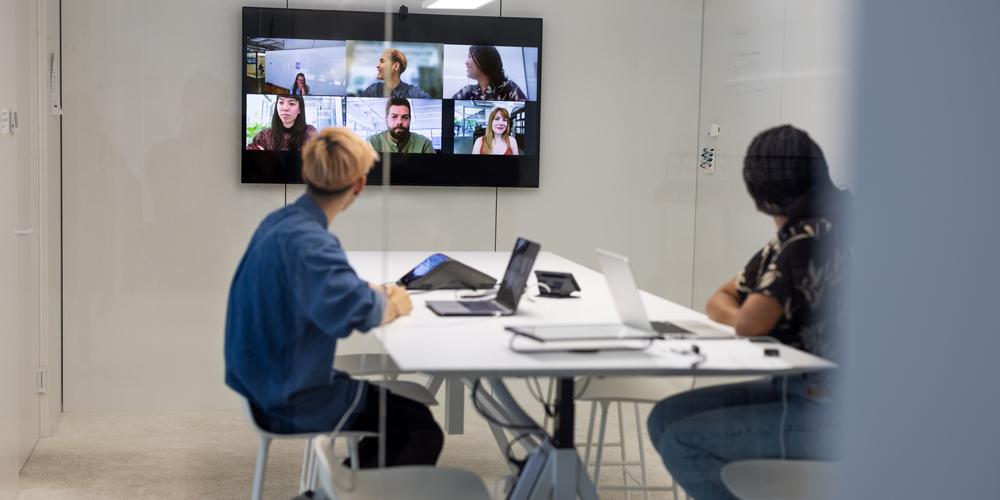Three ways to prevent hybrid work from breaking your company culture
It’s tough to maintain a cohesive culture when half of your employees—or more—regularly work from home. Specific steps can help.
Here’s a situation you might have experienced at your latest team huddle. Half of the group gathers in the conference room as the meeting is about to kick off. But your remote colleagues are busy trying to get connected, and several miss the first few minutes. The discussion gets repeatedly halted by echoes or silenced when remote employees are reminded to take themselves off mute. The conference room doesn’t have a video screen—or a functioning screen that anyone can figure out—so some people in the room dial in on their own laptops, defeating the purpose of an in-person meeting.
Many employees love hybrid work models. But this new approach to work can have a profound impact on their sense of community and connection. A Harvard Business Review study of more than 1,000 employees found that many who worked at least partially remotely felt more excluded from workplace affairs than their in-office counterparts. PwC’s Global Culture Survey 2021 found that among employees who worked from home during the pandemic, 44% found it more difficult to maintain a sense of community with their peers.
And the challenge is not going away. In PwC’s Global Workforce Hopes and Fears Survey 2022, 62% of respondents said they prefer some mix of in-person and remote work, and 63% said they expect their company to offer that kind of approach in the next 12 months.
Overcoming these issues and creating a cohesive culture in which employees can participate in meaningful ways regardless of whether they’re at home or in the office takes more than setting new policies. It requires that leaders take specific steps to create an environment that is connected, inclusive, and productive.
Understand your culture, and link it to explicit behaviors
The first priority is to understand your organization’s current culture—the self-sustaining patterns of behavior that determine how things are done. Given the tremendous shift in ways of working over the past couple years, it’s critical to assess the cultural “thumbprint”—the points of pride and strengths in an organization’s culture, along with the challenges they present—to gauge employee perception and see what may have changed.
Many employees love hybrid work models. But this new approach to work can have a profound impact on employees’ sense of community and connection.
Next, get clear about the “critical few” behaviors that you want to see people doing more frequently to improve performance, connection, and equity. Reinforcing a culture requires translating any proposed changes down to the level of day-to-day behaviors for individual employees.
It’s important that leaders model the target behaviors in a visible way. For instance, if a leader wants to help remote team members feel more included, she can deliberately ask for input from those people on each call. In addition, companies can leverage authentic informal leaders who can influence others in their respective areas of the organization to adopt the behaviors and lead by example.
At a major asset manager, leaders pushed their employees to shift away from strictly focusing on their own responsibilities and instead adopt a more can-do approach. If colleagues were unable to complete their tasks (due to a pandemic-related lockdown, family emergency, or other exigency), other members of the team would step in. Leaders fostered this shift by prioritizing team goals rather than individual performance. They also asked team members to upload stories that showed this principle in action; more than 500 were shared on an enterprise-wide microsite and highlighted on all-hands calls.
Build the right physical environment
The office setup is another key consideration. Companies need to take a hard look at the current environment and gauge how effectively it supports different types of work. Many aspects of office design are based on convention rather than deliberate thought. One analysis found that building thermostats typically have been calibrated for the comfort of men who are 40 years old and weigh approximately 154 pounds, which is cooler than is comfortable for most women. That norm was established decades ago and never updated.
Just about every physical feature of the office can be made more conducive to hybrid work. Technology such as an online whiteboard for meetings, smart cameras that automatically pan to people as they talk, and virtual receptionists help to bridge the gap between virtual and in-office workforces. Even after companies invest in technology, they need to evaluate it to see whether it supports new behaviors—and they will likely need to adjust this technology over time.
For example, a major insurance company upgraded its office to better support hybrid work. It partnered with design firms to replace individual desks with couches and other comfortable furniture arranged in small spaces that can connect to videoconferencing technology. The company also invested in digital whiteboarding tools and collaborative task management software for more reliable communication between in-office and remote team members.
Provide the right support mechanisms
Last, leaders must set employees up for success. These support mechanisms can be quite diverse. The insurance company mentioned above, for instance, created training programs to give its employees the right skills to succeed in a hybrid workplace. These included tactical help on new technology, along with training for managers on effective virtual coaching conversations.
To ensure these mechanisms actually help, companies must identify key metrics such as employee productivity and satisfaction, and invest in systems to evaluate this data over time. Employee engagement surveys are one approach, but other companies are now using monitoring software.
Hybrid work represents a major shift in how companies function, but it need not have a major impact on their culture. By taking some proactive steps, companies can ensure that they have the right culture in place for their employees to thrive, regardless of where they work.
Author profiles:
- Earl Simpkins advises clients on strategy and transformation for Strategy&, PwC’s strategy consulting business. Based in Dallas, he is a principal with PwC US.
- Varun Bhatnagar advises clients on culture and organization for Strategy&. Based in Dallas, he is a manager with PwC US.




